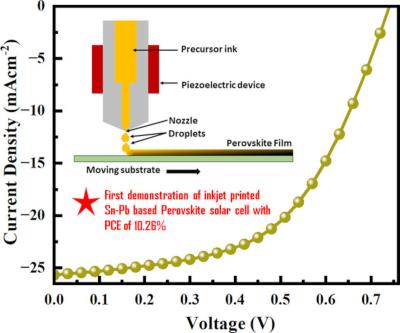A Research Group led by Prof. Eva Unger at Helmholtz Zentrum Berlin (HZB), in collaboration with the Indian Institute of Technology Bombay and University of Jammu, has reported the use of inkjet printing to fabricate thin films of combinatorial mixed formamidinium tin-lead perovskites and evaluated their layer quality and device performance. The team focused on optimizing the inkjet-printing process to ensure precise film deposition and enhance device performance.
Image credit: ACS Applied Materials and Interfaces
The scientists deposited Sn/Pb intermixed FASn1–xPbxI3 (x = 0.25, 0.5, and 0.75)-based perovskite thin films through inkjet printing. The study focused on finding the ideal composition ratio for a favorable photovoltaic performance. The deposited FASn1–xPbxI3 thin films were subjected to various characterizations followed by their implementation in solar cells.
The team's findings demonstrated that incorporating Pb up to 50% into FASnI3 films enhances lattice stability. The investigation focused on optimizing the composition ratio for improved photovoltaic performance with FASn0.5Pb0.5I3-based perovskite solar cells (PSCs) achieving the highest PCE of 10.26%.
Additionally, these cells exhibited an absorption spectrum extending beyond 1000 nm, corresponding to a 1.25 eV bandgap.
The results suggest that inkjet printing can effectively enhance the efficiency of tin–lead-based PSCs, supporting scalability in device manufacturing. This work represents an advancement in the development of lead-reduced, eco-friendly perovskite solar cells through inkjet-printing technology. The study opens up new avenues for eco-conscious, scalable, and efficient solar energy solutions.




